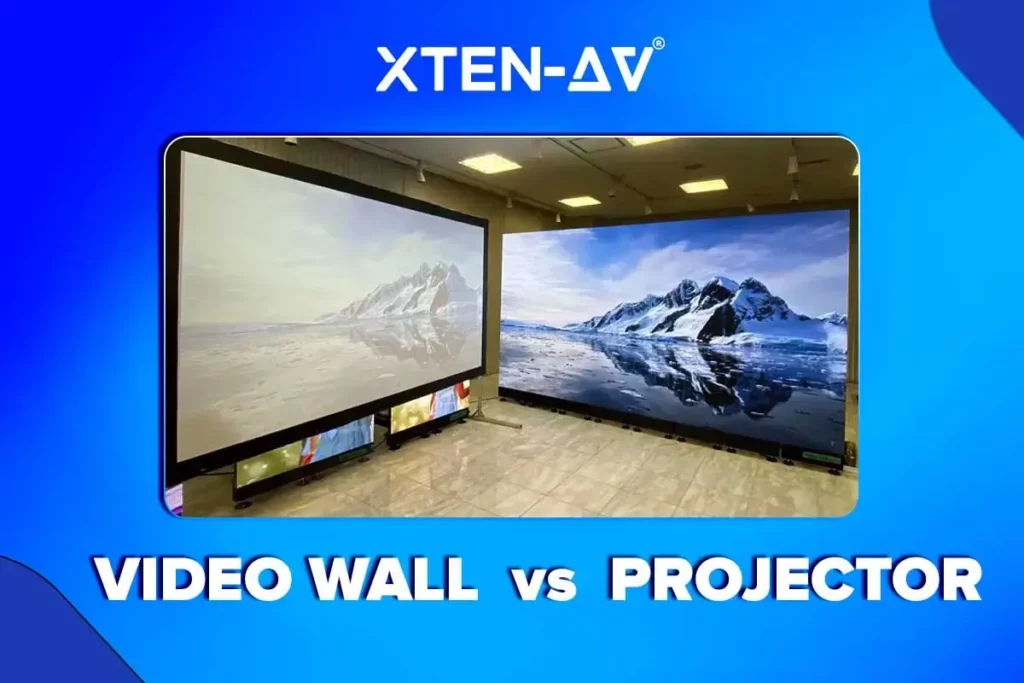Video Wall vs Projector: Choosing the Right AV Technology for Impactful Displays
Do you also need clarification about the video wall vs projector? Well, both have special qualities. Wall projections and projectors provide significant presentation benefits and can help increase participation and involvement levels. However, it is advisable to stick with one technology to make sure operations are clear, which can impact presentation and conference quality. But choosing the best one that fits your requirements becomes crucial.
No worries, here you can read everything from both sides, making your decision easier. Every piece of information is essential when choosing this kind of setup.
The all-in-one solution for your AV needs
Transform your audio-visual experience with XTEN-AV.
No Credit Card required
Key Takeaways:
- Learn the differences between a video wall and a projector and which one is better for your space.
- Compare the benefits of video walls and projectors to find the best fit for your needs. Examine the pros and cons to make an informed decision.
- View insight into the pros and cons of choosing a better option for your company.
- Read the detailed information on the video wall, which has several screen options to produce high-quality images.
What is Video Wall, How Does it Work, Pros & Cons
A video wall consists of multiple screens, ranging from tiny LED panels to LCD monitors, joined or arranged side by side to create one large, unified display. Video walls can work cohesively to show one large image or display different content on each monitor. Most video walls use LED technology, with LCD monitors, tiles, and cubes being common choices.
How Does It Work:
- Multiple Screens: A video wall creates several individual screens that are connected.
- Connection: These screens are connected with special hardware and software to function as one large display.
- Controller: The video wall controller or processor manages the content by splitting the image or video across all the screens, ensuring each screen shows its correct part.
- Synchronization: These screens are synchronized to provide a perfect image without gaps or mismatches.
- Content Management: Software allows users to control the video content. Users can also enable the display of one large image or multiple images and videos on different parts of the wall.
- Flexibility: The setup is simply adjustable by replacing or adding screens as needed, making video walls suitable for various uses and spaces.
Pros
- Increased the visual impact that creates a large, impressive display to grab attention.
- It can display a large image or allow content to flow together flexibly.
- It is Simple to grow by adding new displays.
- High resolution. It can produce a single huge screen.
Cons
- Cost can be expensive to set up and maintain.
- Complexity is necessary for specialized hardware and software to manage.
- Installation requires sufficient room.
- Technical issues include the possibility of screen mismatches or synchronization issues if not properly solved.
What is Projector, How Does it Work, Pros & Cons
A projector displays a picture on a large surface or screen. The projector’s size and lens resolution control its quality and brightness. You may experience the projector in the cinema hall, requiring a dark room to display pictures. Projectors are also commonly used in classrooms, conference rooms, and home theaters to provide a large visual display from a small device.
How It Works:
- Image Source: The projector receives input from a computer or streaming device.
- Light Source: The projector uses a powerful light source, such as a lamp or LED, to illuminate the image.
- Lens System: The illuminated image passes through a series of lenses that focus and magnify it.
- Projection: The focused image is projected onto a surface, such as a screen or wall, where it is enlarged for easy viewing.
- Adjustments: Projectors frequently have tools for adjusting focus, zoom, and keystone correction to ensure the image is clear and properly spaced.
Pros
- The large display can project extremely big images, making it perfect for presentations and home theater.
- Many projectors are tiny and portable.
- Projectors are used with various input sources, including stream computers and devices.
- It is Cost-Effective and generally less expensive than giant TVs or video walls for making enormous displays.
Cons
- Image Quality Resolution and brightness may be lower than on high-end displays.
- Lighting Conditions suffer in bright surroundings. Therefore, it is best viewed in gloomy rooms.
- Maintenance Bulbs and other components may require regular replacement.
- Setup requires a suitable screen or wall and a proper location for optimal viewing.
How Can You Perfectly Position a Projector in Your AV Space?
Choosing between a video wall and a projector is not just about the technology but also understanding the client’s requirements. One major consideration of using a projector is identifying the distance between projector and screen. Let not your client’s struggle with distorted images affecting their viewing experience just because of your miscalculations.
Here’s where XTEN-AV’s projector calculator comes into play. It helps audio visual professionals to provide optimal viewing experience to their clients through accurate screen and projector placement.
What is the better option for you, Video wall vs Projector?
The main choices for large-format content distribution in commercial applications are video walls or projection screens. While projectors might seem like an easy solution, they often need to provide better value than video walls.
Video walls are more efficient and essential for effective communication, data management, and productivity. They offer high-resolution images and videos through LED or LCDs and can show multiple media sources simultaneously. But why is a video wall a better investment than a large display or a projector? Let’s break it down.
Higher Resolution:
The video wall is built with multiple screens, each with high resolution. This means you get clear, sharp images and videos even when they are enlarged. On the other hand, projectors display content with lower resolution, which results in less clear visuals.
Flexible Content Management:
The best part of video walls is that you can easily change what each screen displays. You can show different videos, images, or presentations on different screens at the same time. In the projector, you can’t see this kind of flexibility; you have to manually adjust the screens to change the content.
Lower Maintenance Costs:
Video walls are expensive at first, but they save money over time since they are made to last and require less maintenance. Projectors, on the other hand, require frequent bulb replacements and other maintenance, which can become pricey over time.
Better Visibility:
The LED panels in video walls are bright and clear, even in rooms with a lot of light. Projectors can struggle in bright areas because they require dark rooms for better clarity. It makes video walls better for places with natural light or outdoor settings.
Many cases come in video wall vs projector to pretend one side is more powerful than the other. With our factors, you may clear the basic points running through your mind. Choose the thing that makes you better, not be disappointed.
When To Consider a Video Wall Instead of a Large Projector?
A video wall instead of a large projector would be a good choice. Every aspect would provide you with a better option, but here’s why a video wall might be the suitable option for you:
- Smooth integration
Video walls may be effortlessly integrated into any space, including conference rooms, control centers, and retail environments. They have an attractive, contemporary look that complements the style of any location, whereas projectors frequently require large setups and additional areas for projection.
- Interactive capabilities.
Video walls frequently have touchscreens and interactive capabilities, allowing visitors to interact with the video directly. This is perfect for interactive presentations, wayfinding, and working together.
- Durability and longevity
Video walls are built to last and can withstand continuous use with little wear and tear. They are designed to last longer than projectors, which can overheat and degrade over time with repeated usage.
- Enhanced multitasking
A video wall allows you to display many multimedia sources simultaneously, improving multitasking and monitoring capabilities. It is precious for control rooms, security monitoring, and live event production. In contrast, projectors can only display one content source at a time.
- Excellent color accuracy and consistency.
Video walls provide improved color accuracy and uniformity across all screens, guaranteeing that your graphics are true to life. Color mistakes and fading are possible with projectors, particularly over time.
A video wall is superior for high-quality, flexible, and cost-effective displays. They offer sharper images, easier content management, and better visibility in any lighting condition. Although the initial investment might be higher, the long-term benefits and savings make video walls a smart choice over large projectors.
AV Design Mastery + Winning Proposals = 10x Productivity!
- Automatic Cable Labeling & Styling
- 100+ Free Proposal Templates
- Upload & Create Floor Plans
- 1.5M Products from 5200 Brands
- AI-powered ‘Search Sense'
- Legally Binding Digital Signatures
No Credit Card Required
Conclusion
The selection between a video wall vs projector is based on your needs. Most points highlight that video walls present far better options than projectors. They provide superior clarity, flexibility, and visibility, greatly enhancing the viewing experience. Compared to projectors, video walls may display many pieces of content on different displays simultaneously. Video walls are frequently the preferable choice for a more dynamic and entertaining display layout.
FAQ's
Video walls are generally the better choice. They offer superior clarity, flexibility, and visibility and simultaneously allow multiple content displays. It makes video walls more versatile and engaging than projectors, which can only display one piece of content at a time.
Yes, video walls are worth it. They offer superior clarity, flexibility, and visibility compared to projectors. They allow for displaying multiple pieces of content simultaneously, are highly durable, and require less maintenance, making them a wise long-term investment.
An LED wall is generally better than a TV video wall. LED walls offer higher brightness, better visibility in various lighting conditions, and seamless displays without visible borders. They are also more energy-efficient and durable, ideal for large-scale and long-term use.
Of course, you can use it, but it might need to provide better image quality. Walls can have imperfections and might not reflect light like a dedicated projector screen, resulting in a less precise and vibrant picture. For the best viewing experience, a high-quality projector screen is recommended.


